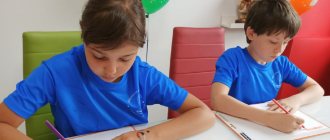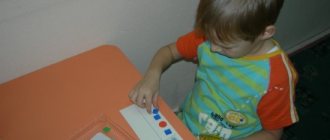Parents of kindergarten-aged children are concerned about how their child speaks, but mothers and fathers of schoolchildren have other problems. As soon as school begins, your child may experience difficulties with written speech. And very often this does not mean that your treasure is not gnawing too hard on the granite of science. Learning difficulties may be associated with speech disorders.
Written speech
Experts refer to written speech as the process of writing letters, words and text itself, as well as their reproduction “from a sheet of paper,” that is, reading. The formation of written speech is a conscious process, the result of targeted learning. Accordingly, some difficulties may arise in children due to imperfections in the psychological sphere - attention, perseverance, concentration, motivation to study. However, educational measures are not always the method of overcoming problems. Often, writing problems have more serious causes that do not depend on the diligence of your schoolchild.
In order for written speech to be formed correctly, several components are necessary:
- A developed system of mental factors - memory, thinking, attention, imagination, ability to self-control, analysis and synthesis.
- Developed motor skills, fine motor skills.
- Ability to perceive - visual, phonemic.
- Correct and well-developed oral speech.
The last point is by no means less significant. It is the level of development of oral speech that is the basis on which a new skill will be built. For this reason, it is extremely important to solve all possible speech therapy problems in a child before starting school.
Impaired writing can manifest itself in different forms, depending on the presence of certain problems. Contacting a speech therapist will help you cope with them and help your child succeed in school.
Three levels of speech development
First level
- “babbling speech”, consisting of onomatopoeia, amorphous words, and sound complexes. Speech is incomprehensible to others and is often replaced by paralinguistic means of communication - gestures, facial expressions. It is difficult for a child to understand spoken speech.
Second
- the beginnings of commonly used phrasal speech. At the same time, the phonetic and grammatical design of the phrase is distorted. The child uses words denoting individual objects, actions and signs, and also notes attempts at inflection and word formation. However, these attempts are most often unsuccessful, as is the reproduction of the syllabic structure of words. Pronunciation and perception of speech sounds are impaired. Addressed speech is generally perceived undifferentiated.
Third
- elementary detailed speech with errors in the use of language units at all levels.
Fourth
- residual manifestations of speech underdevelopment, affecting individual components of the language system and manifesting itself, first of all, in complex forms of speech activity.
With mental retardation, intellectual impairment, and hearing loss, an outwardly similar state of linguistic means may be detected; in these cases, the term “systemic speech underdevelopment” is used, which allows us to delimit the nature of the disorder.
The psychological and pedagogical approach allows us to build a system of teaching children with similar speech disorders. It is these conclusions that are formulated by the speech therapist and used by the psychological, medical and pedagogical commission when developing the child’s educational route.
However, to determine the causes and mechanisms of speech disorders, to build individualized schemes of correctional work and predict its results, speech therapists and doctors use a clinical and pedagogical classification, according to which violations of oral speech (its external or internal, semantic-semantic, design) and written speech are distinguished.
Dyslexia
If your child has difficulty learning to read, he or she may have dyslexia.
It is characterized by:
- Letters in words are read incorrectly (merging with subsequent/previous ones, “swallowing”, substitutions).
- The accents are placed in the wrong place.
- The word is not read to the end.
- During the reading process, words are skipped or rearranged, lines are lost, and transition from one line to another is difficult.
As a rule, dyslexia is associated with speech hearing impairment. It is difficult for a child to distinguish sounds that are similar in pronunciation. Important factors are also the sufficient development of the ability to analyze and synthesize, maintain attention and accuracy of perception.
Dysgraphia
Constant errors in writing, not related to knowledge of spelling rules, are a characteristic feature of dysgraphia. These mistakes are illogical and even unexpected for teachers and parents. “Cow” can turn into “krova”, “April” into “atrel”, letters are turned upside down, and words in a separate sentence are not connected to each other.
Edifications, traditional activities with the child and even punishment cannot lead to results. The whole point is that dysgraphia does not arise from the child’s disobedience, but due to the insufficient formation of higher mental functions and violations of various components of speech.
Articulatory-acoustic dysgraphia
This option occurs when there are problems with sound perception and pronunciation of sounds. That is, the child “writes what he hears.”
- arbitrarily uses voiced and voiceless consonants in writing, changing their places;
- alternates between whistling and hissing sounds;
- skips a soft sign;
- mixes affricates and their components;
- randomly changes vowels of the first and second rows.
The problem cannot be solved until the speech therapist establishes the correct articulation of all sounds and masters phonemic hearing skills.
For example: “cat” - “koska”, “swing” - “rollers”.
The mother-child connection
Why is the mother not just a spectator in the “Successful Start” dyslexia correction course, but actively involved in the correction process? This is explained by the fact that the course provides her with recommendations on harmonizing relationships in the family. She is the one who masters self-help skills for dyslexia and literally learns how to interact with her child again.
There is a scientific basis for this.
Thus, the research group of the Claparède Institute back in the early 1990s. It has been found that the basis of dyslexia is often a negative connection between mother and child. Their relationship is most often based on conflict. For example, a mother forcibly feeds her child, as a result he begins to resist her and gradually transfers this manner to other areas of life. And this manifests itself, first of all, in training. Moreover, the child uses the developed model of behavior in relations with the teacher, as a result of which pedagogical efforts do not have any result.
Dysgraphia agrammatic
In this case, during writing, the grammatical structure of speech is disrupted:
- the connection between words in a sentence is disrupted, phrases are not consistent with each other;
- nouns are put in the wrong number, case or gender;
- prefixes and suffixes are replaced;
- the structure of the sentence itself changes.
The problem becomes noticeable in the 3rd grade, when mastery of grammar becomes a prerequisite for learning. Parents should be careful.
Example: “Beautiful car”, “Katya and Lena are driving a car”.
Optical dysgraphia
Letters consist of a certain set of elements - hooks, sticks, circles, ovals, etc. If there are problems with visual-spatial perception, the process of analysis and synthesis, schoolchildren may experience typical errors:
- letters are written in mirror image;
- extra elements appear in the letters (“porridge” - “kashshsha”);
- the details of the letters “come off” from each other or a gap appears between the written
- letters in one word;
- visually similar letters are replaced (v - d, t - p, i - sh).
Speech therapist for schoolchildren
The problem and correction of specific disorders of written speech, i.e. dysgraphia has always been relevant.
Material from the site
The main task of a speech therapist at a school speech center is the timely identification and prevention of writing and reading disorders.
What is dysgraphia?
Dysgraphia is a partial disorder of the writing process, manifested in persistent, repeated errors caused by the immaturity of the higher mental functions involved in the writing process.
What should a teacher be wary of in students’ oral and written speech:
• incorrect pronunciation of sounds, which can subsequently cause dysgraphia and dyslexia;
• special nature of errors in writing:
- - errors are not the rule;
- persistent errors that do not disappear during the learning process;
- regularly repeated errors in various types of work, regardless of the child’s psychophysical state;
— distortion of graphic images of letters;
- omissions, rearrangements, additions of letters and syllables;
- mixing paired consonants in oral and written speech;
- gross agrammatisms in oral speech and writing.
The practice of working at a school speech center has shown that dysgraphia makes up a significant percentage of other speech disorders found among students in public schools. The causes of dysgraphia can be both unformed processes during learning and mildly expressed underdevelopment of speech. When identifying speech disorders and organizing remedial education for children entering school, signs of general speech underdevelopment often go unnoticed. Typically, dysgraphia caused by mildly expressed underdevelopment of speech is recognized only in the process of learning to write. What is a serious obstacle to students’ mastery of literacy at the initial stages of education, and at later stages to mastering the grammar of their native language.
The writing of dysgraphic children can be determined by the presence of two groups of specific errors:
1) errors
,
due to the immaturity of auditory attention and phonemic processes:
a) omission of letters and syllables - “passed” (forgave), “greedy” (greedy), “ishka” (toy);
b) rearrangement of letters and syllables - “onko” (window), “zvyal” (took), “peperisal” (rewrote), “natuspila” (stepped);
c) underwriting of letters and syllables - “delo” (did), “lopat” (shovel), “nabukhl” (swelled);
d) building up words with extra letters and syllables - “tarawa” (grass), “katorai” (which), “bababushka” (grandmother), “klyukikva” (cranberry);
e) distortion of the word - “naotukh” (to hunt), “habab” (brave), “pike” (cheeks), “specky” (from a stump);
f) continuous writing of words and their arbitrary division - “nasto” (one hundred), “visitnastne” (hanging on the wall), “u stala” (tired);
g) inability to determine the boundaries of a sentence in a text, writing sentences together - “My father is a driver. The work of a driver is difficult; the driver needs to do well. Know the car after school too. I’ll be the driver”;
h) replacing one letter with another - “trick” (three); “u glesta” (crossbill), “telpan” (tulip), “shapagi” (boots);
i) violation of softening of consonants - “vaselki” (cornflowers), “smali” (crumpled), “kon” (horse).
2) errors caused by the immaturity of the lexical and grammatical aspects of speech:
a) agrammatism - “Sasha and Lena are picking flowers. The children sat on large chairs. Five little yellow chickens” (five little yellow chickens);
b) continuous writing of prepositions and separate writing of prefixes - “in the pocket”, “while flying”, “in the village” (took), “on the road”.
Thus, dysgraphia, based on the type of errors it produces, is divided into the following types:
- Acoustic
Articulatory-acoustic
A speech therapist in the practice of a comprehensive school often has to deal with mixed types. But the following manifestations of speech problems in students predominate.
- Articulatory-acoustic dysgraphia,
Material from the site
which is characterized by
the replacement of letters corresponding to phonetically similar sounds,
i.e. similarity in acoustic-articulatory characteristics:
- voiced - voiceless (B-P; V-F; D-T; Zh-Sh, etc.),
- whistling - hissing (S-SH; Z-Z, etc.),
- affricates and components included in their composition (CH-SH; CH-TH; C-T; C-S, etc.).
- Incorrect designation of the softness of consonants in writing: “pismo”, “lubit”, “hurt”, etc.
To overcome this type of dysgraphia, there is only one reliable way - the development of clear auditory differentiation of sounds that are not distinguishable by ear. Until this is achieved, the child will continue to write at random. Therefore, it is necessary by any means to bring to his consciousness the difference in the sound of sounds by emphasizing it as clearly as possible. For this purpose, at the first stage, it is most convenient to identify these sounds with the sounds of the surrounding nature or familiar objects.
Subsequently, the child is offered a wide variety of exercises aimed at distinguishing these sounds.
For example:
• the child naming words with the sounds Ш and С;
• showing the letter Ш or С in response to a word with the corresponding sound pronounced by an adult;
• the child’s naming of the missing letter Ш or С in a word (kry(sh)a, kry(s)a,) s. Such exercises are also carried out in written form. Teddy bear - bowl, roof - rat
• laying out pictures under the letters Ш and С, the names of which contain the corresponding sounds.
When working to overcome articulatory-acoustic dysgraphia, special attention should be paid to the development of auditory differentiation of hard-soft and voiced-voiceless consonants. The lack of such differentiation not only leads to letter substitutions in writing, but also prevents the acquisition of a number of grammatical rules.
In particular, a child who does not differentiate soft and hard consonants by ear will not be able to master the rules for indicating soft consonants in writing - he will always be doubtful whether it is necessary to write a soft sign in words like DAY and DAYS
and which letter (A or Z) should be written, for example, after L in the word LAMP.
To solve this problem, you can perform the following exercises:
- read the words, write them in the singular.
Example: horses - horse
Steppes –
Ate -
Doors –
Carp –
- read the words, write down their diminutive meaning.
Sample: day - days
Coal -
Perch –
- sort the pictures according to the presence of vowels written on the houses
The same is true with voiced and voiceless consonants. If a child does not distinguish them by ear, then he will not be able to master the spelling rule of “doubtful consonants” at the end and in the middle of words (in words like MUSHROOM and MUSHROOM), as well as the spelling rule of many prefixes (in words like RUN and SIGN).
Even having changed the word MUSHROOM so that the dubious consonant is clearly audible (MUSHROOMS), the child will still not get rid of doubts when writing it, since he will not be able to perceive any difference in the sounds of MUSHROOMS and GRIPY.
All work done with the child on auditory differentiation of sounds must be accompanied by written exercises.
Material from the site
Dysgraphia due to a violation of language analysis and synthesis is associated with the fact that the child finds it difficult to isolate some individual words in a continuous stream of oral speech and then divide these words into their constituent syllables and sounds. And without a clear orientation in the sound composition of words, the corresponding letter cannot be selected to denote each specific sound, much less determine their order. As a result, correct writing of words, not to mention phrases, becomes impossible:
- omissions of letters and syllables;
- rearrangement of letters and (or) syllables;
- not completing words;
- writing extra letters in a word
- repetition of letters and (or) syllables;
- continuous writing of prepositions, separate writing of prefixes (“on the table”, “on stepped”).
First of all, you need to teach your child to divide each sentence into separate words and correctly determine their number. In this case, special attention should be paid to prepositions and conjunctions, which are also independent words and therefore are written separately from significant words. For clarity, you can use graphic diagrams of sentences that reflect the number of their constituent words.
- come up with a proposal based on a given graphic scheme;
- make a graphic diagram of this proposal
- (for example: Children are playing.);
- determine the place of each word in a sentence (which one?)
I would especially like to dwell on the importance of dividing words not only into sounds, but also into syllables. Although in general our writing is letter-sound, the unit of reading and writing in Russian is the syllable
. Thus, it is impossible to read the consonant letter P, T, K or any other letter in isolation, without taking into account the vowel that follows it, since it is not known whether it should be pronounced softly or firmly when reading (PA or PY?). Accordingly, in the process of writing in these cases, we must also have in mind the whole syllable at once, since the softness or hardness of the consonant here must be indicated using the subsequent vowel letter.
Material from the site
For this purpose, it is good to conduct exercises on dividing words into syllables with detailed analysis, for example:
- pronounce the words syllable by syllable while clapping your hands,
- name the first syllable, then the second, the third;
show the syllables on the diagram.
Or
- name the vegetables;
- divide words into syllables;
- indicate with an arrow which basket the vegetables should be placed in;
- Explain why?
When the child mastered dividing words into syllables
, you need to teach your child to divide words into syllables and
sounds
.
The following audio analysis tasks are offered:
- determine the number of sounds in a word
- (how many sounds are in words
BALL, BUG, WHALE, SPIDER, FLY, etc.);
- complete the missing cells;
- divide into syllables
- determine the sequence of sounds in a word (which sound is the first
- first, second, third, fourth in the word SPIDER?);
- determine the place of a sound in a word.
To divide words into syllables, a child must, first of all, be able to distinguish between vowels and consonants and identify vowel sounds in a word. For this purpose, you can offer tasks:
- naming only vowel sounds in a word (U and A in the word DUCK),
- inventing words with a certain vowel sound, etc.
And only after the child learns to find vowel sounds without difficulty, can he be told the well-known rule: “as many vowels in a word, so many syllables.”
For sound-letter analysis of words, students always have a tape of sounds and letters
like in the office of every primary class,
and in the speech therapy room.
Timely identification and elimination of oral speech deficiencies in students, as well as special training in preparation for school and from the first days of school, will help prevent failure in writing in this category of children. Therefore, the speech therapist at the speech therapy center assigns a special role to correctional work in the checkpoint and 1st grades.
Material from the site
In our school, CAT, 1st and 2nd grade students make up 80 percent of the total number of children enrolled in speech therapy classes. The successful implementation of correctional work depends on the contact of the speech therapist with primary school teachers. The result of the final survey for the 2010-2011 academic year showed that 56.2% of students who attended a speech therapy center increased their level of mastery of language components.
The interaction of primary school teachers and a speech therapist helps students overcome problems in mastering writing skills and make educational work for children joyful creativity!
List of used literature:
- Efimenkova L.N.
“Correction of oral and written speech of primary school students” - M., 2001.
Dysgraphia that occurs when the processes of analysis and synthesis are disrupted
This option occurs quite often, so parents need to pay attention if the child regularly repeats errors of this kind:
- syllables and individual syllables are swapped or omitted altogether (“doll” - “kulka”, “cook”, etc.);
- words are not completed;
- additional letters appear in words (“machine” - “maashina”);
- prepositions are written together with words, and prefixes, on the contrary, are written separately;
- In words, individual syllables from neighboring words are mixed up.
Let us repeat, the point here is not that the child is not trying hard enough or is not doing his homework diligently enough. Dysgraphia problems have deeper roots. The child definitely needs the help of a speech therapist.
Correct diagnosis of the condition and timely corrective measures can correct the situation and add positive grades to the diary and motivation to study.
USEFUL RECOMMENDATIONS
For correctional work to be effective, follow these recommendations: • Make the environment around the child calm so that he is not distracted from his studies; • Choose tasks taking into account the age and capabilities of the student; • If there is any difficulty, provide help, but do not do everything for the child; • Do not learn foreign words if her dysgraphia is not psychologically ready for this; • Try to speak correctly and pronounce words clearly in the presence of a child; • Do not repeat after the student words that he pronounces incorrectly; • Dysgraphics should use pens with a ribbed surface for writing, which massage the fingertips and increase brain activity; • Support your child so that he does not feel “different from everyone else” (in the worst sense); • Point out his mistakes, but don’t scold him; • Be sure to praise the student for his successes, even if they are minor. Dysgraphia leaves a negative imprint on the learning process, so it is important to detect the disorder as early as possible and contact a specialist. Remember that you cannot eliminate such a problem alone, so parents, doctors and teachers must act together. It is important to prescribe treatment, perform exercises regularly, and constantly increase the child’s self-esteem. Only in this case will it be possible to overcome dysgraphia and related disorders (for example, dyslexia).





